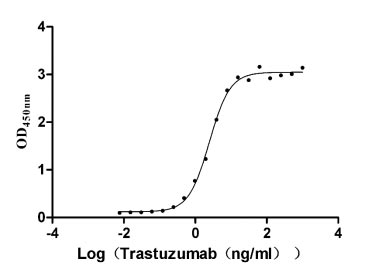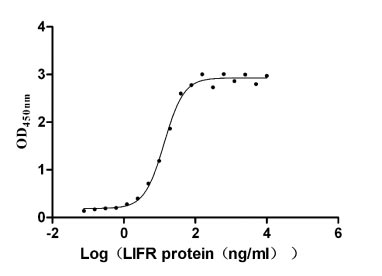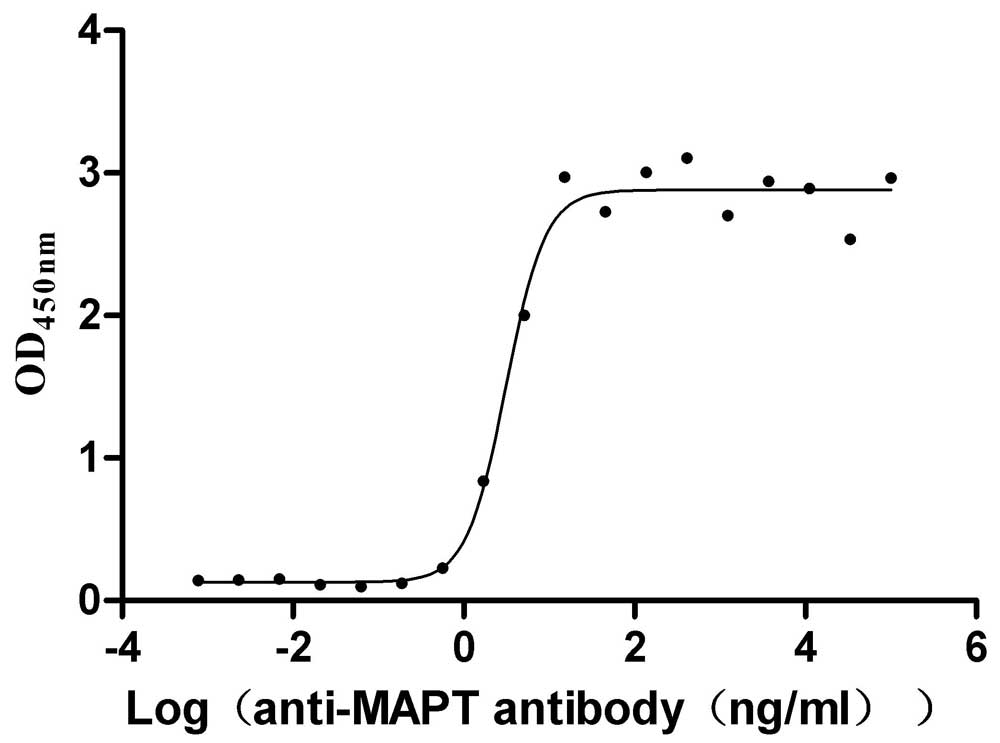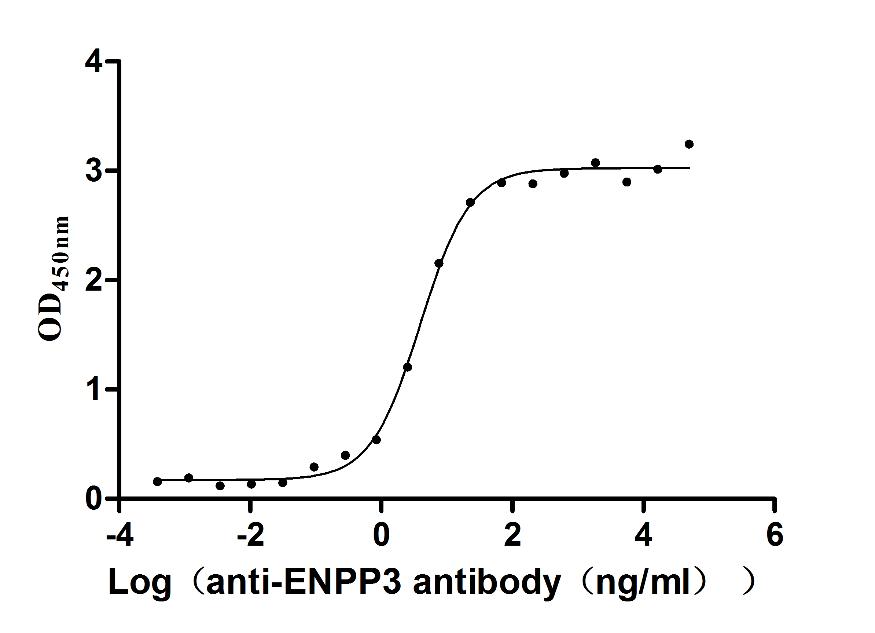Recombinant Mouse Interferon beta (Ifnb1)
-
货号:CSB-YP011048MO
-
规格:
-
来源:Yeast
-
其他:
-
货号:CSB-EP011048MO
-
规格:
-
来源:E.coli
-
其他:
-
货号:CSB-EP011048MO-B
-
规格:
-
来源:E.coli
-
共轭:Avi-tag Biotinylated
E. coli biotin ligase (BirA) is highly specific in covalently attaching biotin to the 15 amino acid AviTag peptide. This recombinant protein was biotinylated in vivo by AviTag-BirA technology, which method is BriA catalyzes amide linkage between the biotin and the specific lysine of the AviTag.
-
其他:
-
货号:CSB-BP011048MO
-
规格:
-
来源:Baculovirus
-
其他:
-
货号:CSB-MP011048MO
-
规格:
-
来源:Mammalian cell
-
其他:
产品详情
-
纯度:>85% (SDS-PAGE)
-
基因名:
-
Uniprot No.:
-
别名:Ifnb1; Ifb; IfnbInterferon beta; IFN-beta
-
种属:Mus musculus (Mouse)
-
蛋白长度:Full Length of Mature Protein
-
表达区域:22-182
-
氨基酸序列INYKQLQLQ ERTNIRKCQE LLEQLNGKIN LTYRADFKIP MEMTEKMQKS YTAFAIQEML QNVFLVFRNN FSSTGWNETI VVRLLDELHQ QTVFLKTVLE EKQEERLTWE MSSTALHLKS YYWRVQRYLK LMKYNSYAWM VVRAEIFRNF LIIRRLTRNF QN
-
蛋白标签:Tag type will be determined during the manufacturing process.
The tag type will be determined during production process. If you have specified tag type, please tell us and we will develop the specified tag preferentially. -
产品提供形式:Lyophilized powder
Note: We will preferentially ship the format that we have in stock, however, if you have any special requirement for the format, please remark your requirement when placing the order, we will prepare according to your demand. -
复溶:We recommend that this vial be briefly centrifuged prior to opening to bring the contents to the bottom. Please reconstitute protein in deionized sterile water to a concentration of 0.1-1.0 mg/mL.We recommend to add 5-50% of glycerol (final concentration) and aliquot for long-term storage at -20℃/-80℃. Our default final concentration of glycerol is 50%. Customers could use it as reference.
-
储存条件:Store at -20°C/-80°C upon receipt, aliquoting is necessary for mutiple use. Avoid repeated freeze-thaw cycles.
-
保质期:The shelf life is related to many factors, storage state, buffer ingredients, storage temperature and the stability of the protein itself.
Generally, the shelf life of liquid form is 6 months at -20°C/-80°C. The shelf life of lyophilized form is 12 months at -20°C/-80°C. -
货期:Delivery time may differ from different purchasing way or location, please kindly consult your local distributors for specific delivery time.Note: All of our proteins are default shipped with normal blue ice packs, if you request to ship with dry ice, please communicate with us in advance and extra fees will be charged.
-
注意事项:Repeated freezing and thawing is not recommended. Store working aliquots at 4°C for up to one week.
-
Datasheet :Please contact us to get it.
相关产品
靶点详情
-
功能:Has antiviral, antibacterial and anticancer activities.
-
基因功能参考文献:
- IFNbeta activates neuronal PI3K/Akt signalling and Akt binds to transcription factor FoxA1 that translocates to the nucleus and induces PDL1. Conversely, inhibition of PI3K/Akt, FoxA1 and PDL1 blocked neuronal ability to generate FoxA1(+)Tregs. PMID: 28436428
- Macrophages activated by metabolic endotoxemia infiltrated into islets and produced IFNbeta, which induced beta-cell apoptosis by increasing the expression of Xaf1. PMID: 29132171
- Reactive oxygen species (ROS) scavenger N-acetyl cysteine (NAC) prevented mitochondrial dysfunctions, type I IFN-stimulated transcript levels, inflammatory cell infiltrate, and muscle weakness in an experimental autoimmune myositis mouse model. Thus, these data highlight a central role of mitochondria and ROS in dermatomyositis . PMID: 28623559
- Nontypeable Haemophilus influenzae DNA as a Pathogen-Associated Molecular Pattern Molecules triggered I-IFN response, which was STING/TBK1/IRF3 dependent. PMID: 29421524
- The Lipopolysaccharide and IFN-beta-mediated increase of STAT1 mRNA and protein levels was abrogated by chelation of Zn(2+) with the membrane permeable chelator N,N,N',N'-Tetrakis(2-pyridylmethyl)ethylenediamine (TPEN) in RAW 264.7 macrophages. PMID: 28965604
- MAVS is essential for spontaneous high basal expression of IFN-beta in cardiac myocytes and the heart. PMID: 28822807
- Mycobacterium smegmatis induces higher Ifnb expression in macrophages than Mycobacterium avium subspecies. PMID: 28422568
- Chronic presence of IFN-I in the brain microenvironment, which negatively affects cognitive function, is mediated via modulation of microglial activity. PMID: 28959042
- In experimental autoimmune encephalomyelitis, IFN-beta inhibited downstream inflammatory cytokines through the inhibition of PI3K/AKT/NF-kappaB axis and p38, JNK-MAPK, as well as the regulation of mTOR complexes. Moreover, IFN-beta inhibited Th17 differentiation and influenced the acetylation of the Il17a and Opn gene promoters. IFN-beta plays a role in Th17 differentiation partly through the inhibition of OPN. PMID: 29127843
- This review briefly discusses the dysregulation of main T cell subpopulations in CNS autoimmunity and summarized the T cell targeted effects of endogenous and exogenous IFN-beta in health and EAE/MS, with emphasis on the direct actions of IFN-beta on each T cell subset involved in the disease. PMID: 27033173
- Rb selectively inhibits innate IFN-beta production by enhancing deacetylation of Ifnb1 promoter, exhibiting a previous unknown non-classical role in innate immunity, which also suggests a role of Rb in the regulation of type I IFN production in inflammatory or autoimmune diseases. PMID: 27267461
- The effect of topical TREX1 knockdown and local interferon production on HIV transmission in human cervicovaginal explants and humanized mice, is reported. PMID: 27184854
- The TBK1 Y179A mutant failed to rescue type I IFN production by virally infected RAW264.7 macrophages deficient in TBK1. PMID: 28049762
- The data demonstrate that an atypical TLR7 signaling pathway contributes to type interferon-beta expression during Y. pestis infection and suggest that the TLR7-driven type I IFN response plays an important role in determining the outcome of plague. PMID: 28847850
- Long-term exposure to atmospheric particulates, PM2.5 up-regulated H3K4 and H3K9 methylation in IL-6 and IFN-beta promoter regions through down-regulating Kdm6a expression. The results suggest that short-term exposure to PM2.5 significantly enhances the survival rate of influenza A-contaminated mice, while long-term PM2.5 inhalation lowers the capacity of pulmonary macrophages to secrete IL-6 and IFN-beta. PMID: 28887033
- Extracellular ATP reduces the replication of VSV, Newcastle disease virus, murine leukemia virus and HSV in vivo and in vitro through the P2X7 receptor; ATP increases IFN-beta expression. Mechanistically, ATP facilitates IFN-beta secretion through P38/JNK/ATF-2 signaling pathways, which are crucial in promoting antiviral immunity. PMID: 28687662
- study reports that mitochondrial antiviral signaling protein (MAVS), -mediated IFN-alpha/beta production and IFNAR signaling are required for alloimmune responses to the human K1 Ag in a murine model of inflammation-induced alloimmunization PMID: 28630094
- study identifies a novel role for RIPK1 and RIPK3, a pair of homologous serine/threonine kinases previously implicated in the regulation of necroptosis and pathologic tissue injury, in directing IFN-beta production in macrophages PMID: 28461567
- results suggest that, in addition to its well-known signaling activity, IFN-beta may be directly antimicrobial and be part of a growing family of cytokines and chemokines, called kinocidins, that also have antimicrobial properties. PMID: 28411186
- results show that resistance to HSV-1 in the trigeminal ganglia during acute infection is conferred in part by STING and IFN-alpha/beta signaling in both bone marrow-derived and -resident cells, which coalesce to support a robust HSV-1-specific CD8(+) T cell response PMID: 27511736
- RIPK3 regulates type I IFN both transcriptionally, by interacting with MAVS and limiting RIPK1 interaction with MAVS, and post-transcriptionally. PMID: 28410401
- neddylation contributes to HSV-1-induced early phase IFN-beta production. PMID: 27593482
- Rubicon specifically interacts with the interferon regulatory factor (IRF) association domain (IAD) of IRF3, and this interaction leads to inhibition of the dimerization of IRF3, which negatively regulates interferon-mediated antiviral response. PMID: 28468885
- Translation arrest is further demonstrated to be key for anti-viral response by acting synergistically with MAVS activation to amplify TBK1 signaling and IFN-beta mRNA transcription, while GADD34-dependent protein synthesis recovery contributes to the heterogeneous expression of interferon observed in dsRNA-activated cells. PMID: 28100675
- The s report that Raf kinase inhibitory protein (RKIP) is essential for TBK1 activation and type I interferon production triggered by viral infection. PMID: 27753621
- this study shows that paracrine type I IFN can profoundly enhance innate recognition and TLR2-dependent transcriptional responses to Francisella tularensis infection upstream of its role in inflammasome regulation in primary murine peritoneal macrophages but not murine bone marrow-derived macrophages PMID: 27231145
- STAT2 recruits USP18 to the type I IFN receptor subunit IFNAR2 via its constitutive membrane-distal STAT2-binding site. PMID: 28165510
- In the exorbital lachrymal gland, the mRNA expression of IFN beta and IFN alpha (type I IFNs) was weak- to strong-positive at 1 days post inoculation (DPI), and became negative at 2DPI. PMID: 27079771
- TBK1 complexes required for the phosphorylation of IRF3 and the production of interferon-beta have been identified. PMID: 28159912
- The s conclude that IFN-alphabeta is pathogenic during chronic Mycobacterium africanum infection and that the pathogenic effects may be mediated through poorer control of bacterial growth. PMID: 27803172
- IRF-1 and interferon-alpha with interferon-beta cooperate to control acute gammaherpesvirus infection. PMID: 27795415
- this study shows that endosomal signalling by Lactobacillus acidophilus that leads to IFN-beta production is inhibited by TLR stimulation from the plasma membrane PMID: 27441725
- Truncated rabies virus phosphoprotein isoforms promote viral replication in muscle cells through their IFN-beta antagonist activities and thereby support infection of peripheral nerves. PMID: 27384657
- identify iNOS/NO as an integral component of IFN-beta production in response to dsRNA in hepatocytes in a pathway that involves the coordinated activities of TLR3/Trif and PKR PMID: 27226571
- Data show that using adipose-derived mesenchymal stem cells (AD-MSCs) expressing interferon-beta (IFN-beta) as an anti-inflammatory agent, offer evidence supporting that the stem cell therapies in experimental autoimmune encephalomyelitis (EAE) may improve the valuable effects of IFN-beta in the autoimmune disease. PMID: 27373971
- NLRX1 was observed to reduce interferon beta and cytokines in response to HIV-1 reverse-transcribed DNA. PMID: 27078069
- This study establishes IL-1beta and IFN-I levels as key homeostatic variables of protective, yet tuned, immune responses against severe invasive bacterial infection. PMID: 26962946
- Type I IFN Does Not Promote Susceptibility to Foodborne Listeria monocytogenes PMID: 26895837
- Results suggest that the lack of autocrine response to interferon-betaI by the host cell may be one mechanism for maintenance of respiratory syncytial virus persistence. PMID: 26501312
- TRIM33 deficiency results in high expression of Ifnb1 at late stages of macrophages activation. PMID: 26592194
- Inhibition of PI3K or Akt abrogated the ability of Syk deficiency to enhance IFNbeta and IL-10 in Syk deficient cells PMID: 26708990
- IFN-beta significantly attenuated the progression of liver fibrosis, with accompanying transcriptional downregulation of the TLR4 adaptor molecule MyD88. PMID: 25715168
- Thus, despite their use of the same receptor, IFNbeta and IFNalpha have unique and distinguishable biologic functions, with IFNbeta being mainly responsible for promoting lymphocytic choriomeningitis virus persistence. PMID: 25974304
- Mice lacking Ifnb function exhibited motor and cognitive learning impairments with accompanying alpha-synuclein-containing Lewy bodies in the brain, as well as a reduction in dopaminergic neurons and defective dopamine signaling in the nigrostriatal region. PMID: 26451483
- Data show that interferon beta knockout IFN-beta(-/-) mice exhibit greater resistance to Salmonella typhimurium infection. PMID: 26202980
- results indicate that Lyn plays a positive regulatory role in RIG-I-mediated interferon expression as a downstream component of IPS-1 PMID: 25585356
- Data show that decreased type I interferon gene expression in T cell subsets of human CASP8 and FADD-like apoptosis regulating protein c-FLIPS transgenic female mice. PMID: 24816846
- Data suggest that Brd4 (bromodomain containing 4) is essential for Toll-like receptor-stimulated interferon-beta (Ifnb) gene transcription by permitting transcription factors to interact with the Ifnb promoter in macrophages. PMID: 25891802
- PP1 directly interacts with IRF3 and dephosphorylates IRF3 at Ser385 and Ser396, resulting in the suppression of TLR- and RLR-triggered IFN-beta production. PMID: 25239187
- Interferons alpha and beta control propagation of long interspersed element-1. PMID: 25716322
显示更多
收起更多
-
亚细胞定位:Secreted.
-
蛋白家族:Alpha/beta interferon family
-
数据库链接:
KEGG: mmu:15977
STRING: 10090.ENSMUSP00000056720
UniGene: Mm.1245
Most popular with customers
-
Recombinant Human Receptor tyrosine-protein kinase erbB-2 (ERBB2), partial (Active)
Express system: Mammalian cell
Species: Homo sapiens (Human)
-
Recombinant Human Leukemia inhibitory factor receptor (LIFR), partial (Active)
Express system: Mammalian cell
Species: Homo sapiens (Human)
-
Recombinant Human Leukemia inhibitory factor (LIF) (Active)
Express system: Mammalian cell
Species: Homo sapiens (Human)
-
Recombinant Human HLA class II histocompatibility antigen gamma chain (CD74), partial (Active)
Express system: Mammalian cell
Species: Homo sapiens (Human)
-
Recombinant Macaca mulatta Microtubule-associated protein tau (MAPT) (Active)
Express system: Mammalian cell
Species: Macaca mulatta (Rhesus macaque)
-
Recombinant Human G-protein coupled receptor family C group 5 member D (GPRC5D)-VLPs (Active)
Express system: Mammalian cell
Species: Homo sapiens (Human)
-
Express system: Mammalian cell
Species: Macaca fascicularis (Crab-eating macaque) (Cynomolgus monkey)
-
Recombinant Human Mucin-17 (MUC17), partial (Active)
Express system: Mammalian cell
Species: Homo sapiens (Human)





-AC1.jpg)














